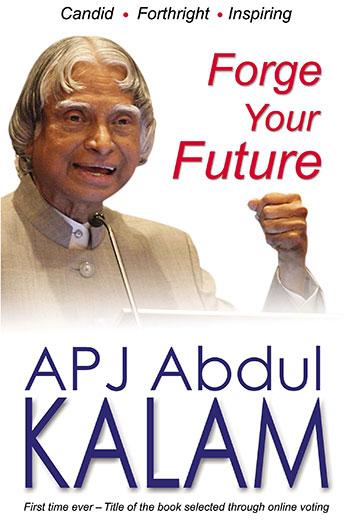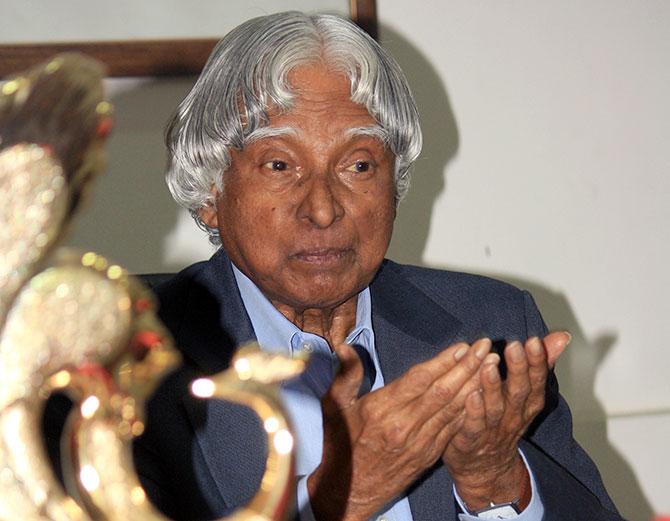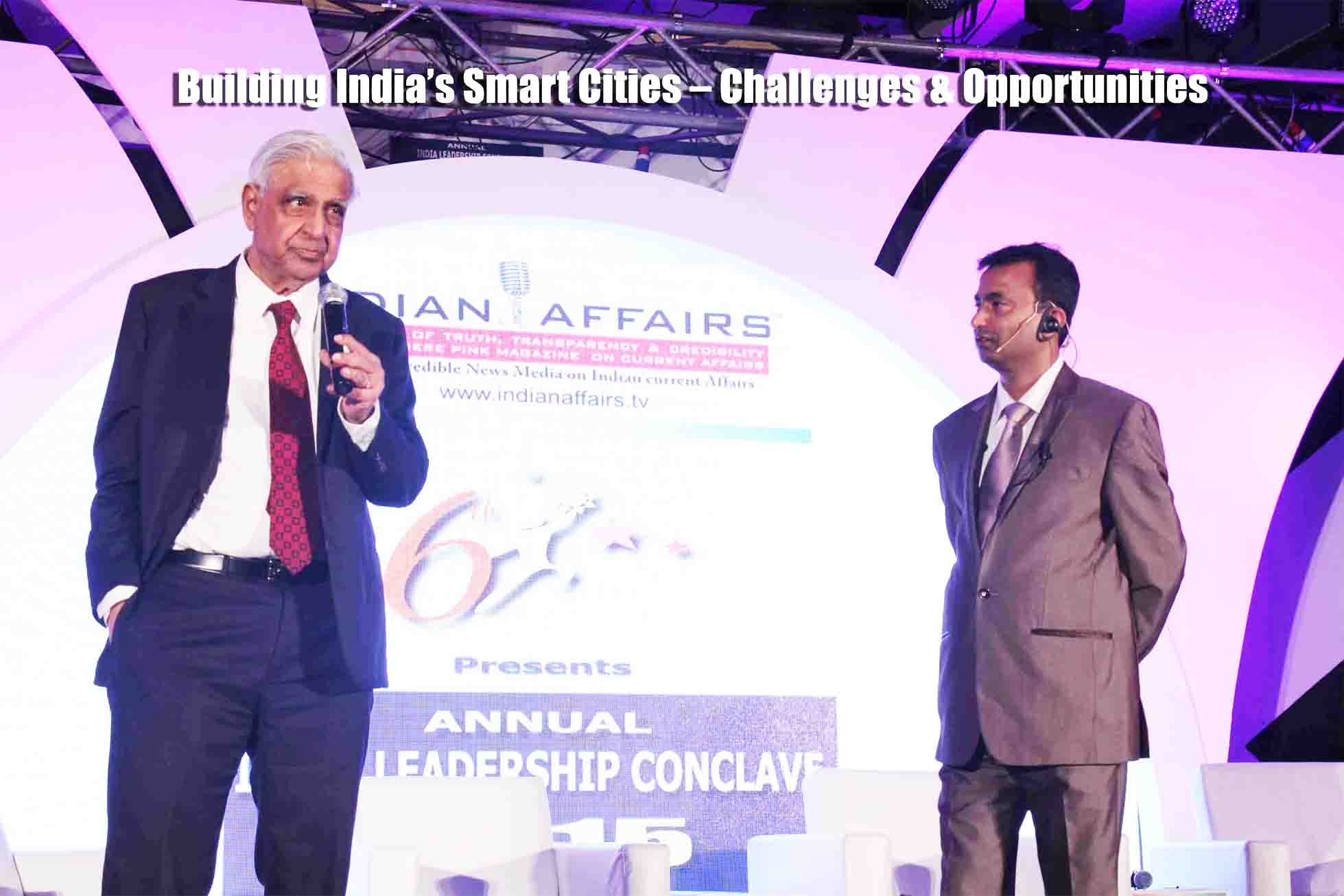

BHARAT has lost a Ratna, but the light from this jewel will guide us towards APJ Abdul Kalam’s dream-destination: India as a knowledge superpower, in the first rank of nations. Our scientist-President -and one who was genuinely loved and admired across the masses – never measured success by material possessions. For him, the counterpoint to poverty was the wealth of knowledge, in both its scientific and spiritual manifestations. As a hero of our defence programme, he shifted horizons; and as a seer of the spirit, he sought to liberate doctrine from the narrow confines of partisan tension to the transcendental space of harmony.
Penned a few thoughts on Dr. Kalam & the phenomenal person that he was. http://t.co/xK2yutu33e
— Narendra Modi (@narendramodi) July 29, 2015
Every great life is a prism, and we bathe in those rays that find their way to us. His profound idealism was secure because it rested on a foundation of realism. Every child of deprivation is a realist. Poverty does not encourage illusions. Poverty is a terrible inheritance; a child can be defeated even before he or she has begun to dream. But Kalamji refused to be defeated by circumstances. As a boy, he had to support his studies by earning money as a newspaper vendor; today, page after page of the same newspapers are filled with his obituary notices. He said that he would not be presumptuous enough to say that his life could be a role model for anybody; but if some poor child living in an obscure and underprivileged social setting found some solace in the way his destiny had been shaped, it could perhaps help such children liberate themselves from the bondage of illusory backwardness and helplessness. He is my marg darshak, as well as that of every such child.
His character, commitment and inspirational vision shine through his life. He was unencumbered by ego; flattery left him cold. He was equally at ease before an audience of suave, globe-trotting ministers and a class of young students. The first thing that struck one about him was that, uniquely, he combined the honesty of a child with the energy of a teenager and the maturity of an adult. He took little from the world, and gave all he could to society. A man of deep faith, he epitomised the three great virtues of our civilization: dama, self-restraint; dana, sacrifice; and daya, compassion.
But this persona was powered by the fire of endeavour. His vision for the nation was anchored in freedom, development and strength. Given our history, freedom had a political context of course; but it also included freedom of the mind and expansion of intellectual space. He wanted India to leap out of the under-developed trough, and eliminate the curse of poverty through inclusive economic growth. Wisely, he suggested that politicians spend only 30% of their time on politics, and 70% on development; a suggestion which he often followed up by calling in MPs from a state and discussing the socio-economic issues of their region with them. The third pillar, strength, was not born of aggression, but of understanding. An insecure nation will rarely discover the route to prosperity. Strength commands respect. His contributions in our nuclear and space achievements have given India the muscle to be confident of her place in the region and the world.

Prime Minister Narendra Modi pays his last respects to former president APJ Abdul Kalam at Palam Airforce Station in New Delhi. (Sanjeev Verma/HT Photo)
His memory is best honoured by the creation of new institutions that nurture science and technology, and enable us to find a beneficial equation with the awesome power of nature. Too often, greed makes us predators of our environment. Kalamji saw poetry in a tree, and energy that could be harnessed in water, wind and sun. We should learn to look at our world through his eyes, and with the same missionary zeal.
Human beings can shape their lives through will, persistence, ability and sheer courage. But we have not been given the right to script where we are born, or how and when we die. However, if Kalamji had been offered an option, this is how he would perhaps have chosen to say goodbye: on his feet, and in front of a classroom of his beloved students. As a bachelor, he was childless. But that is wrong. He was a father to every Indian child, teaching, cajoling, urging, exciting, clearing darkness wherever he found it with the radiance of his vision and the passion of his involvement. He saw the future, and showed the way. As I entered the room where his body lay in state, I noticed the painting at the entrance that depicted a few lines from an inspirational book he wrote for children, Ignited Minds. The good that he did will not be interred with his bones, because his children will preserve his memory through their lives and work, and gift it to their children.
President Pranab Mukherjee and Prime Minister Narendra Modi were among a host of dignitaries who paid tribute to former President APJ Abdul Kalam’s body after it was carried in a special flight from Guwahati to Delhi on Tuesday.
Kalam, who would have turned 84 in October and was the head of state during 2002-07, died after suffering a massive cardiac arrest at the IIM-Shillong on Monday evening.
After being airlifted from Shillong to Guwahati in an air force helicopter, the body was flown to Delhi in a special military flight.
The C-130 Hercules aircraft carrying Kalam’s body touched down at Palam airbase in Delhi at 12.15pm. Wreaths were placed on the body on behalf of the three services, Delhi Police, Delhi chief minister, Prime Minister and President.

Assam CM Tarun Gogoi places a wreath on the casket carrying the body of Kalam at an airforce base in Guwahati on Tuesday. (AFP Photo)

Military officers carry the coffin of Kalam at Palam airbase Station in New Delhi on Tuesday. (AFP Photo)

Kalam played a key role in developing the country’s nuclear weapons.(AFP Photo)

Prime Minister Narendra Modi pays tribute to Kalam at Palam airbase in New Delhi on Tuesday. (AFP Photo)

President Pranab Mukherjee pays tribute to Kalam. (AFP Photo)

President Pranab Mukherjee and Prime Minister Narendra Modi share a moment while paying last respects to Kalam. (AFP Photo)

Another photograph of Mukherjee and Modi at the ceremony. (AFP Photo)

Delhi CM Arvind Kejriwal pays tribute to Kalam. (Vipin Kumar/ HT Photo)

Defence Minister Manohar Parrikar pays last tribute to Kalam. (Vipin Kumar/ HT Photo)

Delhi LG Najeeb Jung and CM Arvind Kejriwal interact with Air Chief Marshall Sardar Arjan Singh after paying tributes to Kalam. (Vipin Kumar/ HT Photo)

Children hold flowers as they wait to pay tribute to the former President while his body is carried from Palam airbase to his house in New Delhi on Tuesday. (Ravi Choudhary/ HT Photo)

School children pay their last respects as the body of former President APJ Abdul Kalam passes from near Gyarah Murti on Tuesday.(Sanjeev Verma/HT)

Children hold flowers as they wait to pay tribute to former Indian President APJ Abdul Kalam, as his body is transported from the Airport to his House in New Delhi. (Ravi Choudhary/HT)

President Pranab Mukherjee (C) and members of military staff salute the body of former President APJ Abdul Kalam at Palam Airforce Station. (Sanjeev Verma/HT)

Once, during his Presidency, President A P J Abdul Kalam received a letter from a student shocked with his class 12th mark-sheet.
He had secured 10 per cent in Maths and Physics, whereas throughout his school career, he had always scored 90 per cent and above.
In utter dismay, he wrote to the President of India, asking for his help.
President Kalam referred his case to the authorities and two weeks later got a reply that indeed there was a mistake in the evaluation and a rectification had been done.
In the last 15 years, President Kalam — arguably India’s most popular President and among the founders of the country’s space programme — has interacted with 18 million young Indians, face-to-face, through e-mail and over Facebook.
He receives 300 e-mails everyday.
Some of these letters have been turned into his latest book Forge Your Future, which provides an insight into the issues which concern and engage the minds of young Indians today. President Kalam’s replies are based on his personal experiences, his reading and his interactions with political and spiritual leaders.
The title of the book was selected after an online public vote.
Dr Kalam, please can you tell me a little about your daily schedule? What’s it like?
The garden here has a 107-year old tree. Edwin Lutyens himself built and stayed in this house — so he maybe somewhere here (laughs).
His relatives had come to see this building.
The 107-year-old tree is beautiful. Parrots and various other birds live at the top and at the bottom live peacocks. Every year there are baby peacocks. I have a very bioactive tree.
I walk for 1 hour and 15 minutes every day. I spend time in my library.
In a month, I spend 15 days travelling in India. For ten days in a year, I go abroad. I am an honorary professor at the University of Beijing.
Every month, I meet a minimum of 100,000 young people. A million people in a year. So far I have met 18 million young people below the age of 25 in my country.
You get 300 e-mails everyday and spend two hours answering them. When did this process begin? When did you start actively engaging with young people?
It all started when I wrote Wings of Fire, in which I conveyed my life, how I had lived it, how I got myself educated, how I started meeting youth…
I was also teaching at Anna University at that time. After my work as scientific advisor, then projector director SLV 3, programme director AGNI — after all that I went in 2001 to Anna University as a professor.
I also get some handwritten letters. I consider them very important and I love to reply to them because they come from people from the grassroots who do not have access to the Internet. They come with unique questions and I have to give unique answers.

You mention what President Mandela told you about courage in your book — who are some of the most inspiring world leaders you have met?
Two world leaders exclusively come to my mind — Mahatma Gandhi and his unique life. Similarly, Nelson Mandela. I went to the prison where Mandela lived.
Where there is righteousness in the heart, there is beauty in the character. That’s the example of Mahatma Gandhi throughout his life.
In 2006, I travelled in the same kind of train with a steam engine from Durban to Pietermaritzburg. I could imagine the courage which Gandhiji showed in that cold winter.
Ahimsa dharma came after the battle of Kalinga. It transformed King Ashoka. The second time ahimsa dharma was put into action was by Mahatma Gandhi at Pietermaritzburg.
This book gives three messages. First: You can become a unique personality. Mahatma Gandhi and Nelson Mandela were unique.
The other important thing about this book is about continuously acquiring knowledge. Thirdly, when the problem arises — become the captain of the problem and defeat it.
You envisioned a growth plan for India called Vision 2020. How close are we to achieving that vision, in view of that deadline being six years away?
Actually India 2020 is a vision for an economically developed India by 2020. Up to 2008 our GDP was 8 to 9 per cent. Then there was a problem across the Atlantic Ocean, and our GDP crashed to 6 to 7 per cent, then to 5.5 and then to 5 per cent.
So in the 2008-2014 period, we had a slack in our development programme.
Six years is a long period in a nation like India with 600 million youth, nowhere in the democratic world there exists this strength.
We also have a natural way of life. Our agriculture is doing well. We have 250 to 260 million tons of food. Our IT, small scale and pharma industries are doing very well.
Of course, we have to do lots in the development of the rural area. We have 600,000 villages where 700 million people live. We have to Provide Urban Amenities to Rural Areas (PURA). Seven thousand PURAS are needed to lift 600,000 villages.
Even now it is not too late. Fortunately, I understand the present government is taking a priority for PURAS. If they push it along with small scale industry and smart waterways, then definitely 2020 — plus or minus 2 years — we can get there.
So you are confident by 2022, that we may be able to do it?
We can do it, provided we have a national vision.
Do we have that national vision?
From 1930 to 1947, we wanted Freedom. Our caste system vanished, our religions vanished, our differences vanished and we were fighting only for Independence. I call that the first mission that India had.
The second vision: Economic development. If you work like that and declare that mission in Parliament and people and government work for it, irrespective of whichever party they belong to, it is possible. Because our resources are youth power and our natural resources.

In your book, you say ‘The orientation must turn from the past to the future and focus on how India can become a developed nation. The real issue is that we are not to see ourselves as a nation and because of that there is no national vision.’
Why do you think we have not been able to see ourselves as a nation?
When we see the types of conflicts all around — religious conflict, caste system, language problems — any big nation will have such types of problems but the nation can be united for a big cause.
Independence was a big cause that united us. That’s why I am pushing this idea that the tool for India Vision 2020 is Providing Urban Amenities to Rural Areas. This way we can enhance village development. I have talked about all this in my book.
Any nation goes through a number of problems in various decades, but India has the experience of bringing together people on a big cause.
I am a believer.
The second great movement that India needs is India 2020 Vision and this will make people come together. Plus if the economic programme grows, the poverty level will come down.
Only a national vision can lift 300 million — that’s one third of the population — below the poverty line out of poverty.
As one of the co-founders of India’s space programme, you must be very proud of our Mars achievement. But at the same time when you say that we have to lift the large masses that remain poor, should not basic needs like healthcare, education, infrastructure precede loftier goals or at least go hand in hand?
The space programme is targeted at uplifting the people. In geosynchronised orbit, more than 200 transponders are communicating to the Indian earth station.
These transponders transmit communication, weather reports, 24 hour TV broadcast, the path of cyclones.
All the recent major cyclones have been forecast by various satellites. 90 per cent of the space programme is for remote sensing and communication. You can remote sense what is the kind of wealth we have on earth like water, minerals etc — so it is intended for the people. 90 per cent of the space programme is intended for the people. It is a people’s programme.
You asked about the Moon and Mars programme. We are spending less than 10 per cent of our space programme for finding and research on Moon and Mars so that we are partners in the research and no one can claim that it belongs to them. I don’t want to see Moon and Mars as the property of some other nation. It should be international property.
Ours is the lowest cost of going to the Moon or Mars and we found trace of water also on the moon. From Mars we don’t know… some revolutionary ideas will come from our Mars programme.
What kind of a leader was Vikram Sarabhai, the founder of India’s Space programme?
When you read this book Forge Your Future, you will know how to become a unique person. It contains the experience of great thinkers and doers. Dr Vikram Sarabhai was a unique personality.
He was a visionary. In 1970 he gave a report about what the nation’s space programme should be for the next 20 years.
What according to you are India’s greatest strengths?
One is our farmer community. Whatever weather condition, whatever shortfall — they will give us 200 million tones of food.
Hats off to our farmers and our agriculture scientists!
Second is youth power. No other democratic nation has 600 million youth. The ignited mind of the youth is the most powerful resource — on the earth, above the earth, under the earth — and we have that.
Third, just like every family asks the government for an economically developed nation; every family has the responsibility to give a great citizen to the nation.
We have 200 million families. Parents have the responsibility to make their children righteous — where there is righteousness in the heart, there is beauty in the character.
Only three people can give a good citizen before s/he turns 17. Father, mother, the spiritual environment and the primary school teacher.
You mention women like Marie Curie and Sister Antonia as role models. Who are some contemporary Indian women role models you admire?
I have great respect for Dr V Shanta, for her contribution towards cancer diagnosis, treatment and teaching how to avoid cancer. I admire the mission of Ela Bhatt, founder of the Self-Employed Women’s Association of India and, of course my favourite, whom I respect because I like Carnatic music — M S Subbulakshmi. I love her music.
When she was alive, I used to go to her music festival.

You say in the book that India needs to cast off its inferiority complex vis-a-vis China and work towards coming together to become a master civilisation because together they constitute 37% of the world’s population.
How can this be achieved in the background of the tension, hostility and border incursions?
I remember in April 2007, I addressed the European Parliament. There were around 800 parliament members from 23 nations.
I told them when I see you all — for hundreds of years you were fighting each other and you generated two World Wars, so a billion Indian people congratulate you. Forgetting all your wars, forgetting the difference of society, you formed a European Union for prosperity and peace.
This should be an example. I had composed a poem and recited it there. They gave a standing ovation.
That is not the issue, the issue is that such nations that created World War I and II, when they came together, we — China and India — are a people of great civilisation, in spite of all the differences, there are some great philosophy that is common.
Buddha and Confucius are common to us.
I believe we have to have a great mission. I suggested when the Chinese president came here that we have a World Knowledge Platform. I teach at the University of Beijing, I told them the time has come that both nations should combine our core competence, our 60 billion dollar business, should become 250 billion dollars.
The border issue we should sort out once for all. People of the European Union fought for hundreds of years, a people who generated two World Wars and Hitler and lost millions of people are a union today for economic growth and peace and it happened in front of our eyes.
So for me the differences between nations can be solved by mutual discussions.
Both sides should decide what we can give and what we cannot. It should be an intensive one month discussion with experts and we should sort it out. I hope the present governments in India and China will do that.
What are your thoughts on the present government?
We are getting into politics, next question!
I just asked your thoughts…
Any elected government will perform in five years. We have to give time.
You believe social media affected the results in 30 to 40 per cent Lok Sabha constituencies. How will social media and the Internet affect future elections?
Social media and the type of information flow should have credibility. It reaches fast. It connects people. It is one of the important mediums for putting forth ideas, thoughts and discussing problems.
In India, we also need contact on the ground, but in the future I see that you can sit in your home with a biometric signature and security approved and you can vote. That way you will have 100 per cent voting. It is a long way off, but I visualise it.
Selection of the candidates will also follow an electronic process — to determine if s/he is a good or bad candidate, how many cases s/he has etc. This will happen, it is only a question of time.


















